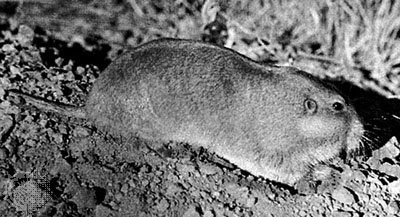pocket gopher
rodent
Introduction
 any of 38 species of predominantly North and Central American rodents (rodent) named for their large, fur-lined cheek pouches. The “pockets” open externally on each side of the mouth and extend from the face to the shoulders; they can be everted for cleaning. The lips can be closed behind the protruding, chisel-like upper front teeth, which thereby allows the gopher to excavate soil without ingesting it. Thickset and cylindrical, pocket gophers are 12 to 35 cm (4.7 to 13.8 inches) in body length, with a short neck, small eyes and ears, and short legs. The five front digits on each muscular foreleg bear long and powerful digging claws. The short, sparsely haired tail is sensitive and well supplied with blood vessels and nerves. Coat colour varies among species from almost white through tones of yellow and brown to black.
any of 38 species of predominantly North and Central American rodents (rodent) named for their large, fur-lined cheek pouches. The “pockets” open externally on each side of the mouth and extend from the face to the shoulders; they can be everted for cleaning. The lips can be closed behind the protruding, chisel-like upper front teeth, which thereby allows the gopher to excavate soil without ingesting it. Thickset and cylindrical, pocket gophers are 12 to 35 cm (4.7 to 13.8 inches) in body length, with a short neck, small eyes and ears, and short legs. The five front digits on each muscular foreleg bear long and powerful digging claws. The short, sparsely haired tail is sensitive and well supplied with blood vessels and nerves. Coat colour varies among species from almost white through tones of yellow and brown to black.Natural history
Pocket gophers excavate long shallow, winding tunnels to obtain roots and tubers (tuber). Burrows (burrowing) for nesting and food storage, however, are deep and extensive and are marked by conspicuous mounds of earth near the entrances. Pocket gophers dig primarily with their front claws and use their front teeth to cut roots and loosen soil or rocks. When moving backward through tunnels, they arch the tail so that its sensitive tip touches the tunnel wall. This allows the pocket gopher to run backward nearly as fast as it can forward.
Occasionally, gophers venture short distances from their burrows to collect succulent herbs, cutting the plants into short pieces and carrying them back in their cheek pouches. Pocket gophers do not hibernate, and stems, roots, and tubers that they hoard in storage chambers enable them to survive the winter. These solitary, pugnacious animals tolerate company only during the breeding season in spring or early summer. About four weeks after mating, the female produces a litter of two to six, and she cares for her blind, hairless young for about six weeks. Then the offspring begin to develop rapidly, and in several more weeks they leave the mother's burrow to excavate their own shelters.
Pocket gophers range from southern Canada and the United States (mostly west of 90° longitude and in Florida), south through Mexico and Central America, to northwestern Colombia. They can be found from coastal areas to above the timberline in high mountains. Between these extremes of elevation, they live in a great variety of habitats from tropical lowlands and grasslands to oak and coniferous forest to mountain meadows.
Classification and paleontology
Pocket gophers constitute the family Geomyidae within the order Rodentia (rodent); their closest living relatives are kangaroo rats (kangaroo rat) and pocket mice (pocket mouse). The evolutionary history of Geomyidae is based on fossils of nine extinct genera found only in North American sediments from the Early Oligocene Epoch (33.7 million to 28.5 million years ago).
Family Geomyidae (pocket gophers)
38 species in 5 genera.
Genus Orthogeomys (giant pocket gophers)
11 Central and South American species.
Genus Thomomys (Western pocket gophers)
9 species.
Genus Pappogeomys (Mexican pocket gophers)
9 species.
Genus Geomys (Eastern pocket gophers)
8 species.
Genus Zygogeomys (Michoacan pocket gopher)
1 species.
- Bedford, Francis Russell, 5th duke of
- Bedford, Jasper Tudor, duke of, Earl Of Pembroke
- Bedford, John Plantagenet, duke of
- Bedford, John Robert Russell, 13th duke of
- Bedford, John Russell, 1st earl of
- Bedford, John Russell, 4th duke of
- Bedfordshire
- Bedford, William Russell, 1st duke and 5th earl of
- Bedlam
- Bedlington
- Bedlington terrier
- Bedmar, Alonso de la Cueva, marqués de
- Bednorz, J. Georg
- Bedny, Demyan
- Bedouin
- Bedreddin
- bedsore
- bedspread
- bedstraw
- Bedworth
- Bedřich Hrozný
- Bedřich Smetana
- bee
- Beebe, William
- beech